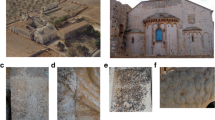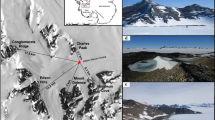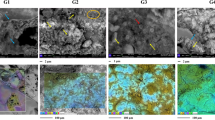Abstract
Next Generation Sequencing (NGS), using the Illumina® metabarcoding system, showed differences between biofilm communities on three degraded siliceous stone church façades in central Rio de Janeiro. Two church biofilms (on granite and augen gneiss) were dominated by Actinobacteria; the third (granite), surrounded by trees and further from intense vehicular traffic, by Gammaproteobacteria. Yeast-like forms of Basidiomycetes and Ascomycetes were major fungi on all facades, but 22.8% of Operational Taxonomic Units could not be assigned to any fungal taxon after DNA amplification with ITS primers and analysis with the UNITE database, indicating the need for more fungal NGS studies. The pipeline used in analysis of the V4 region of rRNA bacterial gene sequences influenced the taxa detected, with two major classes and many genera identified only by the pipeline using the Greengenes, and not the Silva, database. Principal Components Analysis separated façade biofilms into the appropriate three groups and indicated greater dissimilarity of the tree-surrounded church biofilm from the others, confirmed by Jaccard Similarity coefficients, suggesting that local environment influences community composition more than stone type. NGS allows rapid and detailed analysis of microbiomes, but results must be carefully assessed and must not be used as the sole indication of community composition.




Similar content being viewed by others
References
Abad D, Albaina A, Aguirre M, Laza-Martinez A, Uriarte I, Iriarte A, Villate F, Estonba A (2016) Is metabarcoding suitable for estuarine plankton monitoring? A comparative study with microscopy. Mar Bio 163:149. doi:10.1007/s00227-016-2920-0
Brandes M, Albach DC, Vogt JC, Mayland-Quellhors E, Mendieta-Leiva G, Golubic S, Palinska KA (2015) Supratidal extremophiles. Cyanobacterial diversity in the rock pools of the Croatian Adria. Microb Ecol 70:876–888
Celikkol-Aydin S, Gaylarde CC, Lee T, Melchers RE, Witt DE, Beech IB (2016) 16S rRNA gene profiling of planktonic and biofilm microbial populations in the Gulf of Guinea using Illumina NGS. Mar Environ Res 122:105–112
Cutler NA, Chaput DL, Oliver AE, Viles HA (2015) The spatial organisation and microbial community structure of an epilithic biofilm. FEMS Microbiol Ecol 91:1–9
De los Rios A, Ascaso C (2005) Contributions of in situ microscopy to the current understanding of stone biodeterioration. Int Microbiol 8:181–188
Gaylarde P, Gaylarde C (2004) Deterioration of siliceous stone monuments in Latin America: microorganisms and mechanisms. Corros Rev 22:395–415
Gaylarde C, Baptista-Neto JA, Ogawa A, Kowalski M, Celikkol-Aydin S, Beech I (2017) Epilithic and endolithic microorganisms and deterioration on stone church facades subject to urban pollution in a sub-tropical climate. Biofouling 33:113–127. doi:10.1080/08927014.2016.1269893
Gaylarde CC, Rodríguez CH, Navarro-Noya YE, Ortega-Morales BO (2012) Microbial biofilms on the sandstone monuments of the Angkor Wat Complex, Cambodia. Curr Microbiol 64:85–92
Gaylarde C, Ogawa A, Beech I, Kowalski M, Baptista-Neto JA (2017) Analysis of dark crusts on the church of Nossa Senhora do Carmo in Rio de Janeiro, Brazil, using chemical, microscope and metabarcoding microbial identification techniques. Inter Biodet Biodeg 117:60–67
Golosova O, Henderson R, Vaskin Y, Gabrielian A, Grekhov G, Nagarajan V, Oler AJ, Quiñones M, Hurt D, Fursov M, Huyen Y (2014) Unipro UGENE NGS pipelines and components for variant calling, RNA-seq and ChIP-seq data analyses. Peer J 2:e644. doi:10.7717/peerj.644
Gorbushina AA, Kotlova ER, Sherstneva OA (2008) Cellular responses of microcolonial rock fungi to long-term desiccation and subsequent rehydration. Stud Mycol 61:91–97
Gutarowska B, Celikkol-Aydin S, Bonifay V, Otlewska A, Aydin E, Oldham AL, Brauer JI, Duncan KE, Adamiak J, Sunner JA, Beech IB (2015) Metabolomic and high-throughput sequencing analysis—modern approach for the assessment of biodeterioration of materials from historic buildings. Front Microbiol 6:979. doi:10.3389/fmicb.2015.00979
Hoppert M, Flies C, Pohl W, Günzel B, Schneider J (2004) Colonization strategies of lithobiontic microorganisms on carbonate rocks. Environ Geol 46:421–428
Houghton KM, Morgan XC, Lagutin K, MacKenzie AD, Vyssotskii M, Mitchell KA, McDonald IR, Morgan HW, Power JF, Moreau JW, Hanssen E, Stott MB (2015) Thermorudis pharmacophila WKT50.2T sp. nov., a novel isolate of class Thermomicrobia isolated from geothermal soil, and emended descriptions of Thermomicrobium roseum, Thermomicrobium carboxidum, Thermorudis peleae and Sphaerobacter thermophilus. Int J Syst Evol Microbiol 65:4479–4487. doi:10.1099/ijsem.0.000598
Okshevsky M, Regina VR, Meyer RL (2015) Extracellular DNA as a target for biofilm control. Curr Opin Biotechnol 33:73–80
Ortega-Morales BO, Gaylarde C, Anaya-Hernandez A, Chan-Bacab MJ, De la Rosa-García SC, Arano-Recio D, Montero-M J (2013) Orientation affects Trentepohlia- dominated biofilms on Mayan monuments of the Rio Bec style. Inter Biodet Biodeg 84:351–356
Pan W, Byrne-Smith M, Wang C, Lu S, Clemmons S, Zahorchak RJ, Han J (2014) Dna polymerase efficiency preference determines PCR priming efficiency. BMC Biotechnol 14:10
Ruibal C, Platas G, Bills GF (2005) Isolation and characterization of melanised fungi from limestone formations in Mallorca. Mycol Prog 4:23–28
Scheerer S, Ortega-Morales O, Gaylarde C (2009) Microbial deterioration of stone monuments—an updated overview. Adv Appl Microbiol 66:97–139
Shirakawa MA, Gaylarde CC, Gaylarde PM, John V, Gambale V (2002) Fungal colonization and succession on newly painted buildings and the effect of biocide. FEMS Microbiol Ecol 39:165–173
Vázquez-Nion D, Rodríguez-Castro J, López-Rodríguez MC, Fernández-Silva I, Prieto B (2016) Subaerial biofilms on granitic historic buildings: microbial diversity and development of phototrophic multi-species cultures. Biofouling 32:657–669
Author information
Authors and Affiliations
Corresponding author
Rights and permissions
About this article
Cite this article
Ogawa, A., Celikkol-Aydin, S., Gaylarde, C. et al. Microbiomes of Biofilms on Decorative Siliceous Stone: Drawbacks and Advantages of Next Generation Sequencing. Curr Microbiol 74, 848–853 (2017). https://doi.org/10.1007/s00284-017-1257-3
Received:
Accepted:
Published:
Issue Date:
DOI: https://doi.org/10.1007/s00284-017-1257-3




